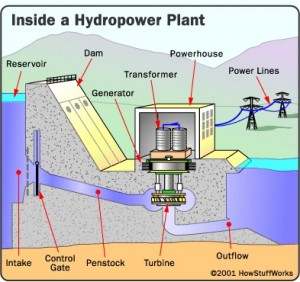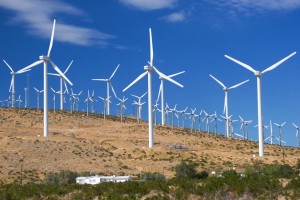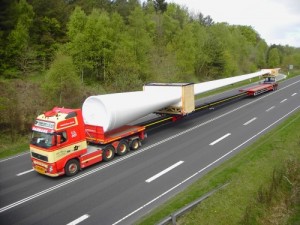This blog was stimulated by an article published in the October 30, 2013 Washington Post: ‘Perfect’ winds blowing Brazil to new era of renewable energy (http://wapo.st/16nattl). It describes a rapid increase in Brazilian onshore wind deployments (the government’s goal is for wind turbines to supply “up to 10 percent of its generating capacity” by 2021) and quotes a Brazilian wind energy company president as saying “Wind is the perfect complement for the hydro base that we have in Brazil.” The purpose of this blog is to put increased focus on the too-little discussed importance of this natural partnership between wind and hydropower.
Hydropower and wind energy are closely related in that both are systems that use turbine blades to convert the kinetic energy of a moving fluid into electricity. In the case of hydropower the fluid is water and in the case of wind energy it is air. In both cases the energy available for conversion is proportional to the third power of the fluid speed V past the turbine – V squared from the kinetic energy in the flow and V from the rate at which fluid is moving through the blades.
Wind energy is a variable (intermittent) renewable energy source that be used as an energy saver for fossil-fuel powered generating systems when the wind is blowing but requires some kind of storage of excess wind-generated electricity if it is to supply electricity at other times. Water reservoirs associated with hydropower dams serve as a natural “storage battery” for variable wind (or variable solar) as hydroelectric generators have short response/startup times as well as flexibility as to when water can be released to the generators from reservoir storage. The combination of wind and hydro thus provides a system capable of firming up power availability even when the wind is not blowing and reduces complementary water releases when the wind is blowing.
But this hybrid system has its limitations. It works extremely well as long as the wind component is not too large and the variations can be handled by the hydropower system’s flexibility. When wind generation gets too big that flexibility no longer exists or becomes increasingly expensive and excess wind energy must be utilized elsewhere. The U.S. Department of Energy’s Pacific Northwest Smart Grid Demonstration, underway in five Pacific Northwest states, is exploring options for addressing this growing problem.
A few more words about onshore wind (today’s dominant form of wind energy; offshore wind, an emerging technology, is discussed in an earlier blog on this web site) and hydropower, both of which are considered mature technologies.
Falling water first became a source for generating electricity in 1879 at Niagara Falls. Today hydropower provides about 20% of global electricity, with China, Canada, Brazil, the U.S. and Russia being the largest producers. There are about 78,000 MWe of hydropower generation capacity from 2,500 dams in the U.S. at present, with an additional 22,000 MWe in pumped storage capacity. Depending on rainfall and water availability, hydro provides about 6-7 percent of U.S. electricity and is currently the largest U.S. source of renewable electricity.
An interesting aspect of U.S. hydropower generation is that while further development of large hydropower projects is problematic (the best sites have already been developed) considerable potential exists for increased hydropower through development of new small and micro hydroelectric plants (59,000 MWe), development of new hydroelectric capacity at existing dams without hydropower facilities (17,000 MWe), and generation efficiency improvements at existing facilities (4,000 MWe).
Onshore wind energy capacity now totals more than 60,000 MWe in the U.S. and more than 300,000 MWe globally. Both numbers are growing rapidly. An interesting aspect of U.S. onshore capacity is the limitation imposed by existing highways – components for wind turbines beyond a given size (about 3 MWe) cannot be accommodated by existing roads. In principle the bigger the wind turbine the better the economics (ignoring the visual and noise impacts), a major argument for putting wind turbines offshore where size is not limited and other impacts are mitigated. One response being examined is manufacturing turbine components (towers, generators) in place using movable manufacturing systems.
In sum, hydropower and wind energy are important sources of renewable electricity with significant growth potential individually and as hybrid partners. Both will be important parts of our inexorable march to a renewable energy future.



